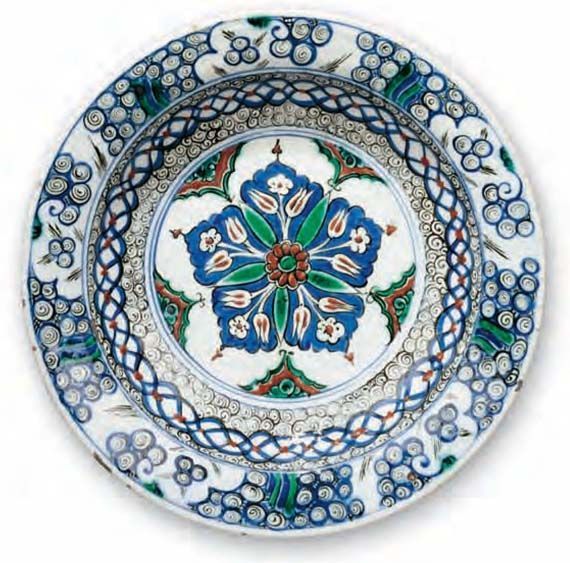Dish With Central Flower, Turkey, Iznik, ca. 1575 –1580
Dish With Central Flower, Turkey, Iznik, ca. 1575 –1580. Fritware, polychrome underglaze painted on an opaque white glaze; Ø 28.5 cm. Kindly lent by Princess Catherine Aga Khan. AKM00586. © 2007 The Aga Khan Development Network.
Ottoman visual culture reached its apex under the reign of Sultan Süleyman the Magnificent (r. 1520-66 CE). Like his predecessors, Süleyman used art and architecture to legitimize his power and authority; unlike them, however, he initiated the creation of a royal aesthetic that would become understood as uniquely Ottoman. In addition to continuing the practice of royal portraiture, which could be transported via medals and albums throughout the empire and to foreign lands, the court’s design atelier, or nakkashane, developed an imperial style that visually unified the Ottoman realm and distinguished it from neighbours and rivals. Before the 1550s, the Ottoman court had relied on an eclectic court culture that drew from both the Iranians to the east and the Europeans to the west. By the mid-sixteenth century, however, these foreign artistic models were synthesized into a classical Ottoman style, which coincided with the replacement of Persian with Ottoman Turkish as the official language of the court. This new artistic vocabulary was immediately recognisable in the medium of ceramics, where a selection of floral, vegetal, geometric and Chinese-inspired elements (arriving via the Timurids in fifteenth-century Iran) were painted under a transparent glaze onto a white, frit body. The tulips, rosettes, carnations, saz leaves, grape designs, and wave patterns on the dish comprise some of the aspects of this distinctive new genre, which was canonized through architectural decoration. The dating of this beautiful dish is based on sources that attest to a move of ceramic production from Istanbul (where the ceramic industry was declining in the shadow of a growing textile industry of kemha, or silk brocade) to Iznik, where potteries thrived from their close proximity to wood and other materials needed for kilns and ceramic production. The symmetrical organisation of geometric and floral ornament seen on many of these wares has been compared to other ceramics produced during the reign of Sultan Murad III (r. 1574-95 CE) and attributed to his patronage based on stylistic and technical comparison to datable architectural tiles from this period (Atasoy and Raby 1989, pp. 246-49).

/https%3A%2F%2Fprofilepics.canalblog.com%2Fprofilepics%2F1%2F0%2F100183.jpg)
/https%3A%2F%2Fstorage.canalblog.com%2F03%2F02%2F119589%2F96711876_o.jpg)
/https%3A%2F%2Fstorage.canalblog.com%2F11%2F31%2F119589%2F94773502_o.jpg)
/https%3A%2F%2Fstorage.canalblog.com%2F20%2F83%2F119589%2F94772815_o.jpg)
/https%3A%2F%2Fstorage.canalblog.com%2F26%2F72%2F119589%2F75604929_o.jpg)
/https%3A%2F%2Fstorage.canalblog.com%2F59%2F60%2F119589%2F26458628_o.jpg)



/image%2F1371349%2F20240421%2Fob_b39e0a_438887545-1653581928745153-28887593908.jpg)
/image%2F1371349%2F20240421%2Fob_37d5a2_437904124-1653574982079181-78090462207.jpg)
/http%3A%2F%2Fstorage.canalblog.com%2F59%2F78%2F119589%2F128999908_o.jpg)
/http%3A%2F%2Fstorage.canalblog.com%2F44%2F97%2F119589%2F128680994_o.png)